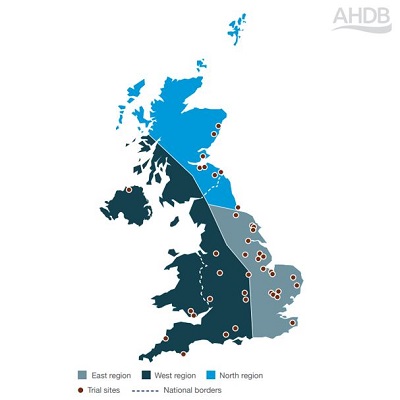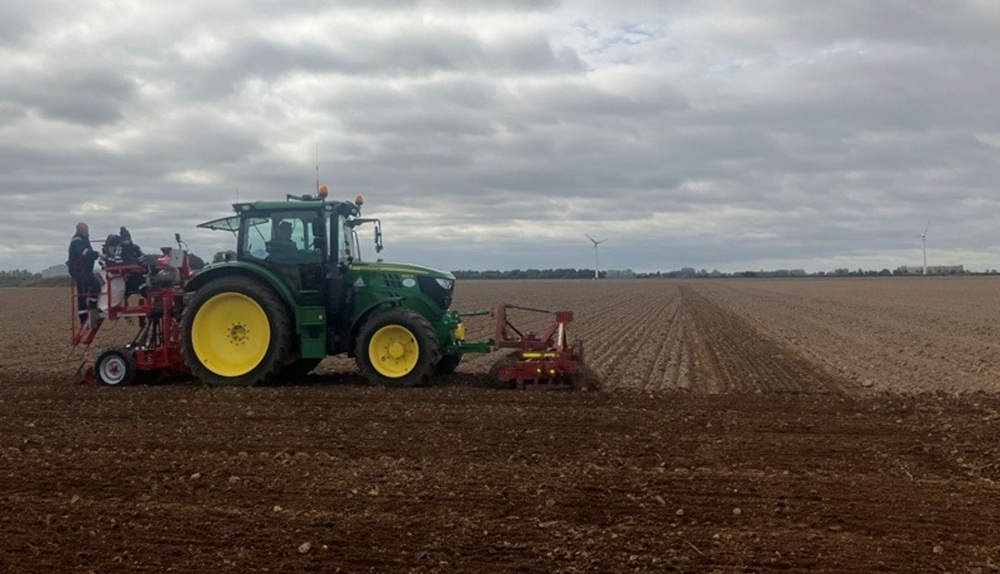- Home
- Knowledge library
- Recommended Lists (RL) winter wheat on trial
Recommended Lists (RL) winter wheat on trial
Follow the team behind the Recommended Lists (RL) on a journey to harvest 2025. Discover how we grow one of the UK’s most complex winter wheat crops, from deciding which varieties to sow to recommendation decisions.
About winter wheat on trial
In the most recent RL review (2022–2023), levy payers asked us to provide more information about the variety trials, including how they operate and how we make recommendation decisions.
For the 2024–25 growing season, we will bring the RL protocols to life from one of our winter wheat trial sites in Norfolk.
Follow the journey to discover how we:
- Select varieties for sowing
- Identify and prepare sites
- Design the trial
- Approach trial agronomy
- Assess and harvest trials
- Decide which varieties to recommend
Trial site facts
Location: Terrington St Clement, Norfolk
Trial type: Winter wheat fungicide treated yield trial (the site also features a fungicide untreated trial)
Unique varieties: 35 recommended, 15 candidates
Number of plots: 150
Previous crop: Potatoes
Soil type: Silty
Tillage: Sub-soiling (4 October 2024) followed by tine cultivation operations, then power-harrowed (7 October 2024)
Sowing date: 7 October 2024 (pre-emergence herbicide applied within a few days)
- This site is one of 31 winter wheat fungicide treated yield trials sown for harvest 2025
- About half of these are in the RL East region (reflecting the relative importance of this part of the UK)
- The UK map of RL cereal regions shows the distribution of all winter wheat trial sites for harvest 2024
- Harvest 2025 has a similar distribution
 AHDB
AHDB
Trial design
RL trials are designed to help manage the influence of in-field variation.
.JPG)
Reps (replicates)
Each variety is grown three times at the site (these are called replicates or ‘reps’).
Each rep features the full variety set, with variety plot positions randomly allocated.
Plot dimensions
- Minimum drilled width = 1.1 m
- Minimum total width* = 1.65 m
- Minimum plot length = 9.0 m
*Includes gaps between plots.
Blocks
Plots are also allocated to a numbered block (which also helps us account for variation across the site).
Guard plots
Some plots are grown to protect variety plots from edge effects (data from such plots is discarded and not used).
Trial (variety and plot) information for the fungicide-treated trial in Norfolk (harvest 2025)
Winter wheat on trial (news)
Learn about the winter wheat on trial initiative (news item)
Winter wheat on trial (vlog)
The AHDB RL team will bring you expert insights about our trials this season, via a vlog on YouTube. Check out the highlights and access the vlog playlist below.
Vlog highlights
For October-sown winter wheat trials, we set a target final spring plant population of 250 plants/m2 or 175 plants/m2. The latter rate is for hybrid varieties, which is 70% of the rate for non-hybrid varieties. Typically, we expect that 90% of the seeds will establish.
Find out how we produce about 15,000 packets of seed each year (YouTube video)
Although the image shows the site being drillled the following autumn (7 October 2025), the principles are the same. It is similar to a commercial set-up, just scaled down. The tractor has front-mounted tines to lightly work the soil ahead of a Horsch disc drill. You can see this drill in action on our YouTube channel.

Five weeks after the trial was drilled, crop emergence and early development were encouraging. There were notable differences in growth across the variety plots (ranging from growth stages 12 to 22). There were numerous fast-developing plots, which can be compared with the fast-growing KWS Extase. These included several UKFM group 2s and candidate varieties.
The plots were holding their lines well. Sometimes, the outside lines of plants in each plot can sink into the plot gaps, especially when wet. Although a risk on this site’s silty soils, the edges were holding up well.
As expected, weed levels were low (we select fields with relatively low weed pressures), with virtually no grass weeds in the plots. The herbicides applied were getting to work on the few broadleaf weeds present.
There were no disease symptoms in the plots. However, some early sown trials towards the North have yellow rust in some plots.
19 March 2025
Mark Bollebakker visited the winter wheat trial site in West Norfolk and made some observations on the untreated trial plots (these will not receive fungicides).
The crops were responding to spring warmth, with varieties associated with early development edging ahead of the rest.
There is no yellow rust on these young plants, however the disease can be seen in the trial at Spalding.
Quite a lot of septoria tritici can be seen in the background, with the classic pycnidia present on the lower leaves. It is primed to set up a good test of genetics in this untreated trial.
UK Flour Millers (UKFM) has now officially confirmed the Group 1 milling wheat status of KWS Vibe. The variety has produced good proteins, under a regime to achieve milling specification, and provided a strong, consistent breadmaking quality (close to Crusoe). Its yield is comparable to Skyfall and has good disease resistance to septoria tritici (6.6). It also has strong resistance to yellow rust (8), which is lacking in some Group 1s.
Gout fly has been spotted at most wheat sites this year (from The Lothians to Hampshire) and some winter barley sites. We usually just see it at one or two sites. Last season, for the first time, we rejected a spring wheat RL trial due to a high infestation of gout fly larvae, which affected the yield data significantly. Adult flies lay eggs on leaves close to the central shoots, usually one per shoot. This season, we are frequently seeing single gouted tillers. To confirm its presence, we can extract the larvae (which are legless, translucent white and lack a distinct head). It differs from wheat bulb fly, where a single larvae can attack multiple shoots. As the crop has tillered well, it is unlikely to affect yields at this site.
6 May 2025
In April 2025, RL trial inspections in the winter wheat North region (initially at our site in Sunderland), found unusual and early signs of yellow rust on many varieties classified as resistant at the young plant (seedling) stage in the latest RL (2025/26).
Mark Bollebakker, vlogged from our winter wheat on trial site at the start of May. The Norfolk site is in the winter wheat East region. Variety plots were around growth stage 37 (flag leaf just visible).
Compared to the North region, yellow rust was less advanced. However, it was starting to develop with a similar pattern to the trials in the North (in terms of varieties affected in the fungicide-untreated plots).
Some of the varieties were showing symptoms on the leaf tips or along the middle of the leaves but the classic stripiness was starting to appear.
Septoria tritici pressure was relatively low.
As the yellow rust pathogen population is highly diverse, it is not unusual to detect new strains. But the observations suggest that the latest change is significant. At present, we do not know how much it will impact adult stage resistance and varieties may still outgrow initial infection, to some extent.
We will continue to assess varieties to determine the full impact of the change.
All varieties will need to be monitored closely, and farmers should also not rely on the disease ratings in RL 2025/26.
An update on the RL trials (YouTube short)
Symptoms at a trial site in Norfolk (YouTube short)
Vlog playlist
RL partnership
The RL project is managed by a consortium of AHDB Cereals & Oilseeds, BSPB, MAGB and UKFM. Funding for the trials and tests is provided by AHDB Cereals & Oilseeds but the production of the RL would be impossible without the contribution and support of the industry.



.png?v=637780281140000000)

